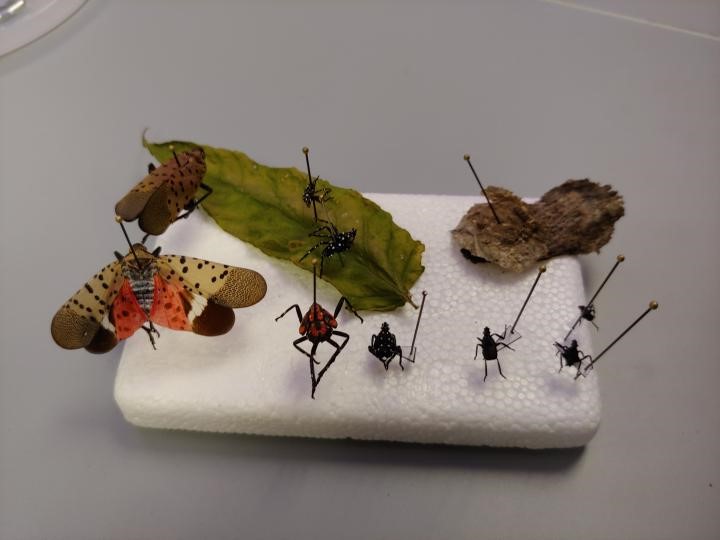Issue 8, July 29, 2021
See If You Can Spot the Spotted Lanternfly
As with all insects, spotted lanternfly has a life cycle that contains various stages of development. The adults can be found from July through December. While fall clean up preparations and tasks will soon be here, attention to detail will be important. The spotted lanternfly could go undetected easily unless awareness is raised. It’s red coloration in the fall may allow for easier detection. Although when the adults are at rest, the red color of the hind wings are hidden under the speckled grey-brown forewings. They are easy to recognize as adults because of their size, and coloration, but the nymphs have a black and white appearance. Early detection is so important, so becoming familiar with the life cycle can assist in identification.

All the stages of spotted lanternfly (Lycorma delicatula) represented in this pinned display. Photo courtesy Amy Stone
Spotted lanternfly is an invasive pest that is a planthopper that can easily hop a ride on human transport items; cars, campers, trucks, and trailers are just to name a few. First discovered in Pennsylvania in 2014, the pest has spread in July 2021, to Switzerland County, Indiana near the Ohio River. Invasive pests can be spread long distances by people who move infested material. Firewood can be a carrier of invasive pests and caution should be noted with the movement of firewood. There hasn’t been a reported arrival in Illinois yet. It’s so important to take caution as if it has because of the devastating effect that can follow.
The spotted lanternfly is known to find over 100 species as host plants. The favored host is Tree of Heaven (Ailanthus altissima). Foliar and stem treatment of Tree of Heaven is recommended from July to mid-October for best results. Tree of Heaven is particularly hard to eradicate because of its clonal reproduction especially after the removal of a tree. The other host plants are quite concerning for a potential Illinois inhabitation of spotted lanternfly. Apple, peach, rose, walnut, sugar maple, grapes and hops are a few examples.
Adults and nymphs feed on host plants with piercing-sucking mouthparts that cause the plants to ooze or weep with extensive feeding. A fermented odor may also be noticed with the presence of spotted lanternfly. These insects excrete a sticky fluid (honeydew) on plants that may develop into sooty mold on infested plants or objects under the canopy of infested trees.
Spotted lanternfly overwinters in egg masses that can be laid on anything outdoors with a hard surface. It’s just not firewood to be on the lookout for moving this pest. The egg masses can resemble cracked mud and may be difficult to find to an untrained eye.
Get to know this pest before it gets to know you. If you suspect, or see this pest in Illinois, please email: lanternfly@illinois.edu, or contact Illinois Department of Agriculture at 815-787-5476 for phone-in reporting. Check your local Extension office for identification resources for spotted lanternfly and other invasive pests.
Author:
Andrew Holsinger